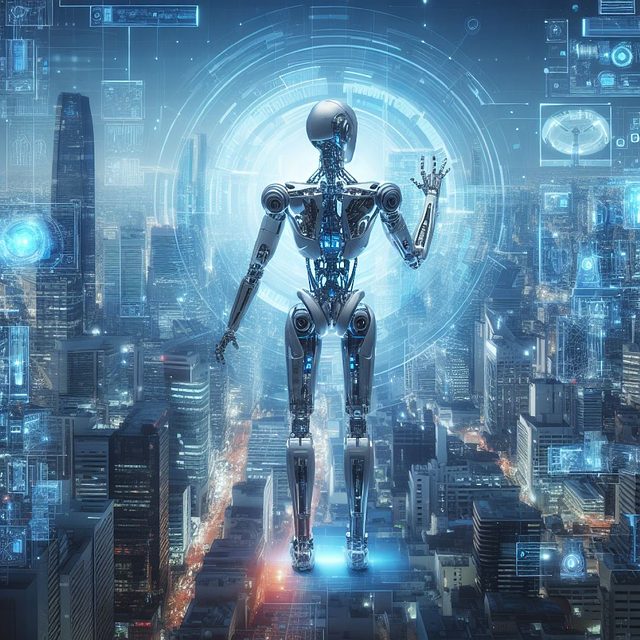AI chatbots, driven by natural language processing (NLP) and machine learning, revolutionize human-computer interaction with dynamic conversations. These intelligent assistants interpret user inputs, learn from vast datasets, and provide personalized assistance across diverse applications like customer service. Ochatbots, powered by advanced NLP, continuously improve through deep learning techniques, ensuring contextually relevant responses. Their development focuses on intuitive dialogue flows, error accommodation, and knowledge base integration for empowering user experiences.
Curious about how AI chatbots revolutionize interactions? This comprehensive guide demystifies their inner workings. From understanding the core basics of AI chatbot functionality to exploring machine learning algorithms and natural language processing (NLP), we delve into the key components powering these intelligent assistants. Discover how training with vast datasets enables ochatbots to adapt and respond seamlessly in diverse scenarios, enhancing user experiences.
- Understanding the Core: Basics of AI Chatbot Functionality
- Training and Data: The Fuel that Powers Ochatbots
- Natural Language Processing (NLP): Decoding Human Communication
- Machine Learning Algorithms: The Brain Behind Adaptive Responses
- Interactive Dialogue: Designing User Experiences with AI Chatbots
Understanding the Core: Basics of AI Chatbot Functionality

AI chatbots have revolutionized the way we interact with technology, offering natural and conversational interfaces that mimic human dialogue. At their core, these intelligent assistants rely on a complex interplay of technologies, primarily artificial intelligence (AI) and machine learning algorithms. The basic functionality of an AI chatbot revolves around processing user inputs, understanding context, and generating appropriate responses.
The process begins with natural language processing (NLP), where the chatbot interprets human language, identifies keywords, and comprehends the user’s intent. This is followed by sophisticated AI models that learn from vast datasets, enabling them to predict and generate relevant outputs. These models continuously evolve through machine learning techniques, improving their accuracy and adaptability over time. As a result, AI chatbots can engage in dynamic conversations, provide personalized assistance, and offer valuable insights across various applications.
Training and Data: The Fuel that Powers Ochatbots

AI chatbots, like any intelligent system, are powered by vast amounts of data and meticulous training. The process begins with gathering a diverse dataset that mirrors the type of interactions the chatbot is expected to handle. This data includes a wide range of user queries, responses, and contextual information. For instance, an AI chatbot designed for customer service would need access to numerous customer inquiries, product details, and relevant company policies.
Once collected, the data undergoes preprocessing, which involves cleaning, organizing, and structuring it to ensure quality and consistency. This critical step prepares the data for training algorithms that learn from patterns and relationships within the dataset. Machine learning techniques, such as natural language processing (NLP), enable AI chatbots to understand user inputs, generate appropriate responses, and adapt to new scenarios over time. Regular updates with fresh data further enhance their performance, making them more effective and reliable in interacting with users.
Natural Language Processing (NLP): Decoding Human Communication

AI chatbots rely heavily on Natural Language Processing (NLP), a subfield of artificial intelligence, to understand and interpret human language. NLP is essentially about teaching machines to decipher the nuances of human communication, enabling them to process text or speech input and derive meaningful context. This involves complex tasks such as text classification, sentiment analysis, named entity recognition, and semantic understanding. By breaking down human language into patterns and rules, AI chatbots can generate appropriate responses that mimic natural conversations.
In the case of an ochatbot, NLP allows it to process user queries, identify keywords, and comprehend the overall intent behind the message. It then uses this information to search its vast knowledge base or generate a response using language models. The more data an AI chatbot is trained on, the better it becomes at understanding and generating human-like text, making interactions with these chatbots seamless and engaging for users.
Machine Learning Algorithms: The Brain Behind Adaptive Responses

AI chatbots are driven by sophisticated machine learning algorithms that enable them to understand and generate human-like responses. These algorithms learn from vast amounts of data, allowing the chatbot to adapt and improve over time. By analyzing patterns in user inputs and comparing them to relevant information, AI chatbots can provide contextually appropriate replies.
Machine Learning (ML) techniques, such as natural language processing (NLP) and deep learning, power the adaptive responses of these chatbots. NLP enables the system to comprehend the nuances of human language, including context, sentiment, and intent. Deep learning algorithms, particularly neural networks, play a crucial role in training the chatbot’s models by identifying complex patterns in data, resulting in more accurate and nuanced interactions. This continuous learning process ensures that AI chatbots evolve to better assist users over their operational lifespan.
Interactive Dialogue: Designing User Experiences with AI Chatbots

AI chatbots are designed to facilitate interactive dialogues with users, mimicking human conversations. These interactions are crafted through sophisticated natural language processing (NLP) algorithms that enable chatbots to understand and respond contextually relevant queries. By leveraging vast amounts of data, AI chatbots learn from user inputs, continually improving their responses over time.
User experiences with AI chatbots are shaped by thoughtful design considerations. Developers must carefully craft conversational flows that feel intuitive and engaging. This involves creating diverse dialogue paths, accounting for potential user errors, and integrating knowledge bases to provide accurate, context-aware answers. The goal is to foster a seamless interaction where users feel guided yet empowered, ensuring the chatbot serves as a valuable tool rather than a mere automated response system.
AI chatbots have revolutionized the way we interact with technology, offering intuitive and adaptive conversational experiences. By understanding the intricate balance of training data, natural language processing, and machine learning algorithms, these virtual assistants continue to evolve, enhancing user engagement and providing valuable support across various industries. As ochatbots become increasingly sophisticated, their potential to transform customer service, information retrieval, and even creative collaboration remains limitless.
